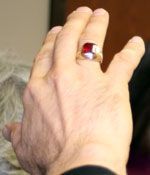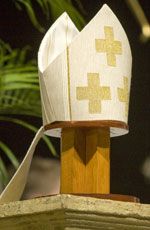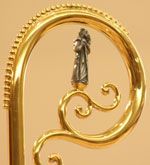Most Rev. Anthony B. Taylor
A bishop is a priest who is chosen by the pope to serve the Church in union with him as a successor of the apostles. Once chosen, a special Mass is held where the priest is ordained. This is known as an episcopal ordination.
During this event, the new bishop receives the fullness of the priesthood because he becomes a successor of the Apostles, meaning that he now has the authority to lead in a direct line to the men thereby chosen by Jesus.
When a bishop is selected to lead a diocese, he is installed as head of that diocese. He is given a pastoral staff (usually called a crozier), symbolic of his role as chief shepherd of the diocese, and an episcopal ring, symbolizing his unique bond with the diocese he serves.
Bishop Taylor's episcopal motto is "The Humble Shall Inherit the Earth." It is taken from Psalm 37:11 and is quoted by Jesus in the Beatitudes in Matthew 5:5. ... In English, humble and meek describe a person's attitude, but the Hebrew refers also to humble circumstances, being marginalized by external factors of poverty and bigotry.

When a priest is chosen to become a bishop and given care of a diocese as well, the episcopal ordination and installation usually happen during the same Mass.
Bishop Anthony Basil Taylor was ordained and installed as the seventh bishop for the Diocese of Little Rock on June 5, 2008 at the Statehouse Convention Center in Little Rock.
Bishop Taylor wore the episcopal ring of the diocese's first bishop, Andrew J. Byrne and carried the crozier of the fourth bishop, Albert L. Fletcher.
For everyday use he wears a ring that once belonged to his grandfather, Basil C. Taylor, who was a faithful Catholic his entire life and he uses various other croziers which belong to him personally when celebrating Mass outside the Cathedral of St. Andrew in Little Rock.
His episcopal motto is "The Humble Shall Inherit the Earth." It is taken from Psalm 37:11 and is quoted by Jesus in the Beatitudes in Matthew 5:5. Bishop Taylor explained that the humble in his motto should be understood in the sense of the underlying Hebrew word Anawim.
In English, humble and meek describe a person's attitude, but the Hebrew refers also to humble circumstances, being marginalized by external factors of poverty and bigotry.
Through the Office of the Bishop, Bishop Taylor shepherds the people of the diocese with the assistance of his priests who lead the parishes and ministries under the bishop's guidance and leadership. Together they work to proclaim the Good News of Jesus Christ with the goal of leading all people to eternal life in heaven.
- Source & See more at:
http://www.dolr.org/bishop#sthash.mymFCLjn.dpuf
Episcopal Insignia
The episcopal insignia for Bishop Taylor were blessed at a vespers service held on the eve of his ordination and installation as bishop. It was held at Christ the King Church. The insignia are signs of his pastoral office.

The Ring — is always worn on the ring finger of the bishop’s right hand. It is the symbol of fidelity to the nuptial bond he has with the Church. Bishop Taylor chose to wear the ring of Little Rock’s first bishop, Andrew Byrne.
During the ordination, Bishop Taylor was presented his ring these words: “Receive this ring, the seal of your fidelity: adorned with undefiled faith, preserve unblemished bride of God, the holy Church.”
The Miter — is the liturgical headpiece worn by the bishop when exercising his office. Two bands called “lappers” hang from the back down onto the shoulders maintaining a connection with the original band bound about the head as a turban.
During the ordination, the miter was placed on Bishop Taylor's head with these words: "Receive this miter, and may the splendor of holiness shine forth in you, so that when the chief Shepherd appears you may deserve to receive from him an unfading crown of glory."


The Pastoral Staff — or “crosier” is held in the left hand. A bishop carries it at liturgies celebrated in his own diocese. Bishop Taylor chose to use the staff of Little Rock’s fourth bishop, Albert Fletcher.
During the ordination, Bishop Taylor was given his staff with these words: “Receive the crosier, the sign of your pastoral office: keep watch over the whole flock in which the Holy Spirit has placed you as bishop to govern the Church of God.”
Source -
https://www.dolr.org/bishop/episcopal-insignia
Episcopal Coat of Arms
The following explanation of Bishop Taylor's coat of arms was provided by Deacon Paul Sullivan of Providence, R.I.
Blazon
Arms impaled. Dexter: Azure, inverted Latin Crosses Argent, upon a saltair of the second a six-pointed star of the first. Sinister: Argent, a cruciform tridentine anchor vert diagonal leaning downward suspended over eaves gules.

Significance
Crest of Most Rev. Anthony B. Taylor
The arms of Bishop Taylor appear on the left (facing) side of the shield, joined with those of the Diocese of Little Rock and surrounded by the bishop's motto and the heraldic symbols of his office.
The diocesan arms of Little Rock are composed of the Marian colors, silver (the same as white in heraldry) and blue. They honor Mary as the patroness of the United States under her title of the Immaculate Conception.
Since Peter is the "petra" (rock) upon which the Church was founded by Jesus Christ, the diocese is represented by small inverted silver crosses in memory of his crucifixion and his head to the earth.
The cross in the form of the letter X is the Cross of St. Andrew, the patron of the diocesan cathedral and the baptismal patron of Bishop Andrew Byrne, its first ordinary.
The star of six points is derived from the coat of arms of Pope Gregory XVI, who established the Diocese of Little Rock on Nov. 28, 1843. Bishop Taylor's personal arms proclaim that the cross of Jesus is our secure hope in times of adversity.
The red waves represent the water of baptism and the blood of the Eucharist as prefigured in the events of the Exodus: the waters of the Nile turned into blood, the blood of the Passover Lamb sprinkled on the Israelites' doorposts, prefiguring that of Jesus poured out on the cross, and their passage through the Red Sea, prefiguring our salvation from the power of sin and death through baptism.
They also represent the pastoral challenge of the Church today: the blood of martyrs like Father Stanley Rother of Oklahoma, the blood of the victims of abortion and the Rio Grande across which immigrants continue to come. The red waves also refer to the Red River which unites Texas, the state of Bishop Taylor's birth, with Oklahoma and Arkansas, the states in which he has served as a priest and bishop.
The green cruciform tridentine anchor represents Christian hope anchored by faith in the Blessed Trinity. The color green and the anchor are traditional symbols of hope. The cruciform anchor leans downward to represent a preferential option for the poor: Jesus coming down from heaven to save us and we who follow him leaning downward to lift up those who are oppressed.
Bishop Taylor's episcopal motto is "The Humble Shall Inherit the Earth." It is taken from Psalm 37:11 and is quoted by Jesus in the Beatitudes in Matthew 5:5. Bishop Taylor notes that humble in the motto should be understood in the sense of the underlying Hebrew word Anawim. In English, humble and meek describe a person's attitude, but the Hebrew refers also to humble circumstances, being marginalized by external factors of poverty and bigotry.
Source - https://www.dolr.org/bishop/episcopal-coat-of-arms
